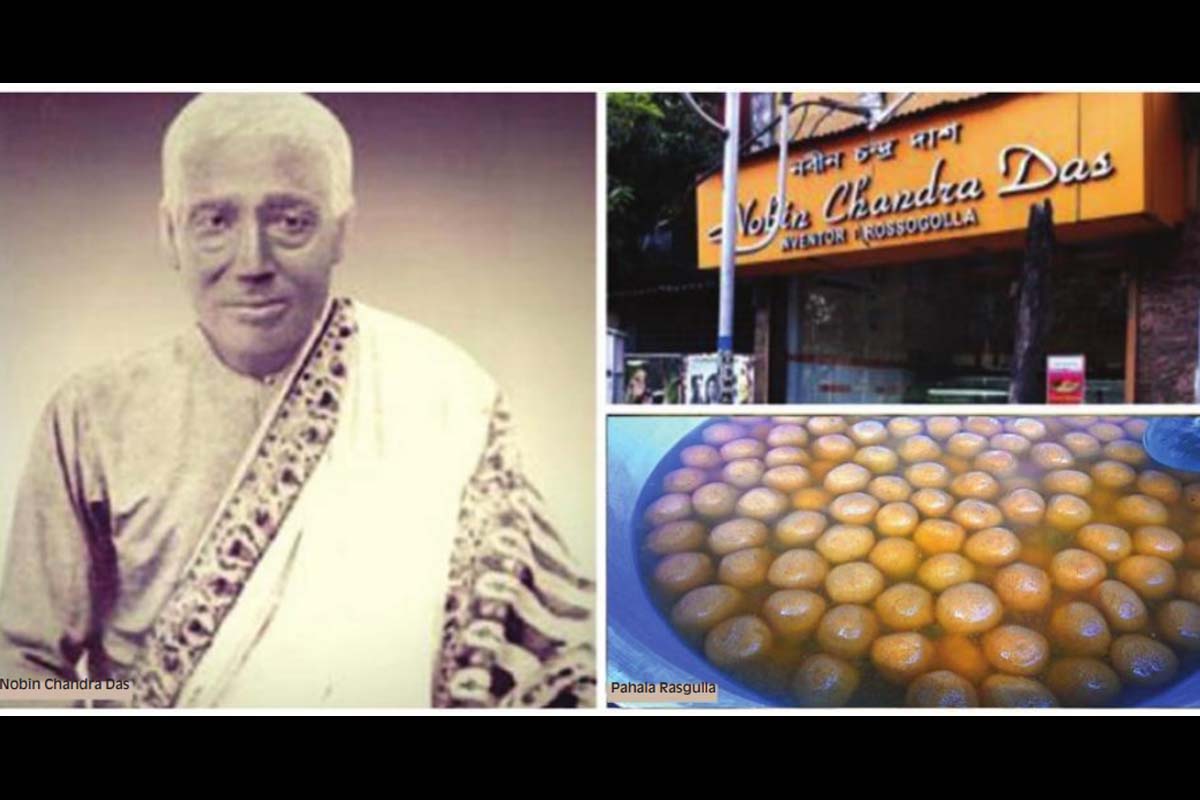West Bengal observed ‘Rosogolla Day’ with pomp and grandeur to celebrate the second anniversary of being granted the GI tag for ‘Banglar Rosogolla’ on 14th November, 2019. The statue of Nobin Chandra Das, popularly known as the ‘Columbus of Rosogolla’ and also the inventor of variety of sweets at Bagbazar area of North Kolkata was garlanded in the presence of state minister Sashi Panja. As a part of the celebration people in many parts of the state were treated with free distribution of Rosogollas at sweetshop counters. Almost all the sweetmeat shops not excluding those in remote villages in the state dedicated the day absolutely to Rosogolla. In 2018, the first ‘Rosogolla Day’ coincidentally observed the 150th anniversary of this popular dessert in 1868.
Bengalis and Rosogolla are almost synonymous. The sweet relation between the Bengalis and Rosogolla was established officially when “Banglar Rosogolla” is awarded GI (Geographical Indications) status by the Registry Office of India of Chennai in 2017. The battle over the GI status reached its climax in 2015 when Odisha’s science and technology minister Pradip Kumar Panigrahi claimed that more than one committee set up to trace the origin of this sweet dessert pointed to “conclusive evidence” that this syrupy dessert had originated in Puri for about 600 years ago. It was argued that ‘Pahala Rasgulla’ evolved from its first incarnation of ‘Khiramohana’.
Advertisement
On the other hand, the West Bengal government referring to 19th century history claimed that Rosogolla was invented by Nobin Chandra Das in 1868. But Odisha’s arguments fell flat when the GI Registrar Office at Chennai in its clarification observed that Bengal and Odisha versions of this syrupy sweet are different in texture and taste. Therefore, West Bengal was given GI status only for the Bengali version of Rasgulla as ‘Banglar Rasogolla’, not for the sweet’s origin.
According to Odisha based historians, Rasgulla originated in Puri as Khiramohana which later evolved into ‘Pahala Rasgulla’. Goddess Lakshmi at Jagannath Temple, Puri has traditionally been offered Rasgulla as ‘bhog’ since the inception of Jagannath’s Ratha Yatra. As per legend, Lord Jagannath in His 9-day sojourn to His aunt’s house was accompanied by His sibling brother and sister Balabhadra and Subhadra without the consent of His consort Goddess Lakshmi. When Lord Jagannath returned from Gundicha Yatra to the main temple at Puri, livid Lakshmi locked the Jai Vijay Dwar to prevent Lord Jagannath with His retinue to enter the sanctum sanctorum of the temple.
Then Lord Jagannath offered Rasgulla to woo His consort Lakshmi. The celebration of the arrival of Lord Jagannath after 9-day Rath Yatra popularly known as “Niladri Bije” includes the ritual called ‘Bachanika’, a long argument between Lord Jagannath and Goddess Lakshmi. The debate ends with the offering Rasgulla to appease Goddess Lakshmi. The ritual is still being observed in Puri Ratha Yatra festival. It is also claimed that the holy ‘Chhappan Bhog’ (56 offerings) of Lord Jagannath has Rasgulla.
Another folk tale handed down to the people of Odisha is that a village named Pahala situated between Bhubaneswar and Cuttack in the old days would produce abundant milk as there the cows outnumbered human beings. Naturally, the excess milk having been spilled would be drained away. Noticing this, a priest of Jagannath Temple taught the villagers how to curdle the milk and also the recipe of Rasgulla. The new dessert gained much popularity in the area. Even according to an eminent Bengali culinary historian, Rasgulla kept its pace in Bengal holding the hands of Odia cooks employed in Bengali homes in the mid18th century.
But there is much room of contradiction when a few historians view that ‘Rasogulla’ was not referred to as one of the 56 offerings of Lord Jagannath in the early temple of Puri. It was reportedly considered taboo to offer something made of split milk to Hindu deities. According to K. T. Achaya, an eminent food historian, splitting of milk was considered taboo in the ancient Ino-Aryan culture. He pointed out that there are several references of milk, butter, ghee etc except sour milk cheese. However, eminent food historian Michael Krondl emphasises on different regional dietary customs.
Besides, it is believed by many that chhena (cottage cheese), the main ingredient of Rosogolla, was discovered by the Portuguese in Bengal in the 17th century. Curdling the milk with acid i.e. acidset cheese or chhenawas reportedly first prepared under Portuguese influence in Bengal. The European practice of splitting milk in India was first traced at Bandel, a Portuguese settlement in Bengal. Bandle cheese which was used to prepare Rosogolla is still, though by name only, popular in Kolkata. Before the introduction of chhena(cottage cheese) khoa (concentration of milk with heat to one-fifth of its original volume), not chhena, was widely used to prepare sweets.
The name of the dessert ‘Rosogolla’ or ‘Rasgulla’ is a compound word. It is derived from the words ~ ‘ras’ (juice) and ‘gulla’ (sphere/ball). Therefore, ‘ras’ or syrup is one of the main ingredients of preparing this sweet dessert. The syrup used for Rosogolla is more transparent and lighter and less sticky than that of which is used for other syrupy desserts. So, the preparation of syrup for Rosogolla requires fine grade of sugar.
There was adequate supply of fine grade sugar in Kolkata in the mid-19th century because of several sugar factories close to the city. Needless to say, it encouraged large production of Rosogolla. Whereas the syrup used for preparing Rasgulla in many parts of Odisha and even in rural Bengal is thicker, so that the products are not spoiled easily.
Needless to say, the spongier version of ‘Banglar Rosogolla’ involves intricate techniques and science in its recipe. On the other hand, Pahala Rasgulla reportedly originated in Odisha is larger in size, redder in colour and sweeter in taste. Rosogollas vary in shape, size, texture and taste in various parts of Bengal, too. Even the taste of piping hot Rosogollas is quite different from those ones in normal temperature especially depending on the permeation of the syrup into the desserts. There is perhaps no standard yardstick to name it Banglar Rosogolla.
Nobin Chandra Das, a Bengali confectioner, is widely considered the Father of Rosogolla. He is referred to as the ‘Columbus of Rasgulla’. He reportedly created this round spongy dessert in the second half of the 19th century. Rosogolla is one of the many other creations including ‘Abar Khabo’, ‘Dedo Sandesh’ etc made by him. There are many stories surrounding the invention of Rosogolla by Nobin Chandra Das. His innovative spirit encouraged him not to be confined in so-called Bengali sweets.
He dreamt of bringing a revolution in the world of confectionery by manufacturing original sweets. His relentless endeavours to create Rosogolla out of fragmented clumps of cottage cheese saw the light of success in his Bagbazar sweetmeat shop in 1868. However, instead of seeking the patent of his sweet discovery, he wanted to spread the recipe to popularise Rosogolla all over the country.
The dessert was reportedly rechristened as Rasbari, Rajbhog, Rasmalai etc in different provinces of the country by the grace of Bhagwanda Bagla, a very wealthy timber merchant residing in Kolkata. There is a legend behind Mr. Bagla’s affection for Rosogolla.
One day when the opulent merchant stopped at Nobin Chandra Das’s sweetmeat shop, his grandson became thirsty. The merchant asked for a glass of water from a boy of the shop. The grandson of Mr. Bagla was served water with Rosogolla to quench his thirst. The grandson savoured the taste of the dessert so much that Mr. Bagla also relished it. Mr. Bhagwandas Bagla took special initiative to spread the fame of the sweet not only in Bengal but also in other parts of the country. Because of his interstate timber business, the popularity of Rossogolla spread far and wide including Uttar Pradesh, Rajasthan and other provinces. In 1930, Rasogolla was first canned and exported to different countries by KC Das, the only son and progeny of great Nobin Chandra Das, and attained the glory of global popularity.
Nobin Chandra Das’s Rosogollas were unique in taste and texture. There is a popular legend about this. Pashupati Bhattacharya, a renowned physician, used to carry Rasogolla from Mr. Das’s outlet when he visited Tagore. One day he failed to buy Tagore’s favourite sweet dessert from Mr. Das’s shop and purchased them from a nearby shop. Tagore discerned the difference and asked the doctor to bring Rosogolla only from Das’s shop.
Even in Bengal too, there is a bone of contention over the invention of Rosogolla. It is also considered by some historians that Rosogolla was first invented accidently by Haradhan Moira, a sweetmeat maker of the famous Pal Chowdhurys of Ranaghat. He had reportedly dropped balls of chhenaand semolina into boiling syrup. This was the first Rosogolla which was reportedly later developed and marketed by Nobin Chandra Das. However, this theory of the inventions of the sweet is not widely accepted.
Popularity of chhena-based sweets especially Rosogolla passed through a hard time during the second half of the 20th century. Preparation of chhena based sweets including Rosogolla was banned in Calcutta when Prafulla Sen was the Congress Chief Minister of West Bengal. The ban was imposed by the West Bengal Chhanna Sweets Control Order because of acute scarcity of milk. Per capita milk in the state then plummeted to less than 3 ounces that was very low compared to most other states. As a result of the ban, the situation worsened so much that the backbone of Bengal’s sweet industry was broken. Many shifted to nonchhannaproducts. Even the first rate shop holders were compelled to shut down their outlets and thousands of workers were retrenched.
The battle over the origin story of Rosogoll is seemingly over as both West Bengal and Odisha have been accorded GI status for their own different versions in texture and taste. But ever-increasing number of diabetic patients is going to be a severe setback for this quintessential delicacy. Coincidentally, the birthday of Banglar Rosogolla and World Diabetic Day are antithetically observed on the same day, 14th November. Rosogollas are considered poison to diabetic patients.
They are often advised to eat limited number of this dessert after squeezing out the syrup as much as possible. But Rosogolla without ‘ros’ is equal to ‘golla’ (zero). An ardent Rosogolla fan said, “Relishing Rosogolla is not just a partial bite. Putting a giant Rosogolla inside one’s wide open mouth, relishing the soft white chenna with popping eyes with the syrup dripping down from the chin adds divine joy to the taste.”
Another ambivalence involving this Rosogolla is that this round-shaped dessert is regarded both inauspicious and auspicious simultaneously. Zero marks in examinations are often compared to Rosogollas. On the contrary, any celebration regarding good results in examinations, winning in elections and successes in other fields of everyday life of the Bengalis is incomplete without distribution of Rosogollas among well wishers. Besides, charming children with ‘chubby cheeks, dimpled chin’ are often equated with this round, white and soft dessert.











